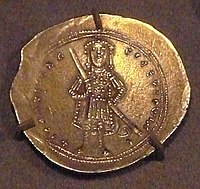Isaac I (Byzantium)
Isaac I Komnenos ( Middle Greek Ἰσαάκιος Αʹ Κομνηνός ; * around 1005 ; † 1061 in Constantinople ) was Byzantine emperor from 1057 to 1059 .
Life
Isaac was the son of an officer of the emperor Basil II named Manuel Komnenos Erotikos , who entrusted his two sons Isaac and John to the care of the emperor on his deathbed . Basil had them carefully educated in the studio monastery and then placed them in high positions. During the reign of Basil's seven immediate successors, Isaac won the trust of the army through his shrewd action , so that in 1057 he stood against the Emperor Michael VI with the nobility of the capital Constantinople . could ally. After his deposition, he was crowned emperor and founded the Komnenen dynasty .
Isaac's first concern was to provide his noble allies with offices that would keep them away from the capital. His second was to restore the empire's financial strength. He revoked many of the pensions and grants his predecessors had given to idle courtiers. In addition, he secured a share of the income of the rich monasteries, whereby he anticipated the accusation of sacrilege by Michael I. Kerularios , the Patriarch of Constantinople , by means of an exile order. Isaac's only military activity was with the Hungarians and Pechenegs , who began in 1059 to devastate the northern borders. Shortly after the successful campaign, he was attacked by a disease that he considered fatal. He then appointed Konstantin Dukas as his successor, passing over his own brother Johannes, the father of the future Emperor Alexios I , and his wife Anna Dalassene .
Although Isaac recovered, he did not take the purple back, but retired to the studio monastery, where he spent the remaining two years of his life as a monk. His scholia on the Iliad and other works on Homer's poems have been preserved. Isaac's great goal was the restoration of the organization of the government and his reforms, although unpopular among the nobility and clergy and not understood by the people, certainly did something to delay the fall of the Byzantine Empire for a while.
literature
- Κωνσταντίνος Βαρζός: Η Γενεαλογία των Κομνηνών (= Βυζαντινά Κείμενα και Μελέται. Τ. 20α , ZDB ID 420491-8 ). Τόμος Α '. Κέντρο Βυζαντινών Ερευνών - ΑΠΘ, Θεσσαλονίκη 1984, pp. 41–47 No. 4, digitized version (PDF; 264 MB) .
- Jean-Claude Cheynet: Pouvoir et contestations à Byzance (963-1210) (= Publications de la Sorbonne. Series Byzantina Sorbonensia. Volume 9). Reimpression. Publications de la Sorbonne Center de Recherches d'Histoire et de Civilization Byzantines, Paris 1996, ISBN 2-85944-168-5 , pp. 68-70 No. 80.
- Wolfgang von Rintelen: Isaak I. Komnenos , in: Biographisches Lexikon zur Geschichte Südosteuropas . Vol. 2. Munich 1976, p. 238
- Alexios G. Savvides, Benjamin Hendrickx (Eds.): Encyclopaedic Prosopographical Lexicon of Byzantine History and Civilization . Vol. 3: Faber Felix - Juwayni, Al- . Brepols Publishers, Turnhout 2012, ISBN 978-2-503-53243-1 , p. 329.
- Mihail-Dimitri Sturdza: Dictionnaire Historique et Généalogique des Grandes Familles de Grèce, d'Albanie et de Constantinople. 2nd Edition. Self-published, Paris 1999, ISBN 904747 .
- Thomas Uecker: Isaak I. Komnenos. In: Biographisch-Bibliographisches Kirchenlexikon (BBKL). Volume 2, Bautz, Hamm 1990, ISBN 3-88309-032-8 , Sp. 1345-1347.
Remarks
- ↑ Sturdza ( Dictionnaire. P. 274) lists Nikephoros Komnenos as the eldest son.
| predecessor | Office | successor |
|---|---|---|
| Michael VI. |
Emperor of Byzantium 1057–1059 |
Constantine X. |
| personal data | |
|---|---|
| SURNAME | Isaac I. |
| ALTERNATIVE NAMES | Isaac I. Comnenus |
| BRIEF DESCRIPTION | Byzantine emperor (1057-1059) |
| DATE OF BIRTH | around 1005 |
| DATE OF DEATH | 1061 |
| Place of death | Constantinople |

